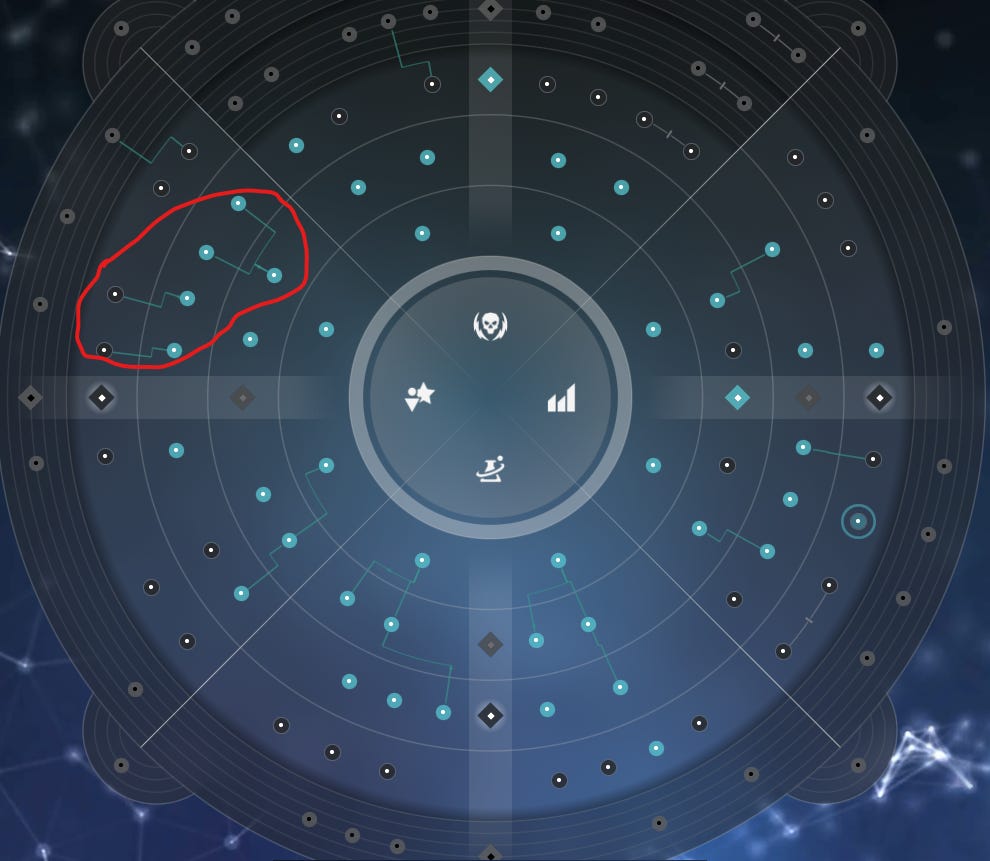114B. Using 4X to Explain the AAA Tech Deadend
I explain how inventions occur in general, and how a failure to understand this process has led to AAA spending billions of dollars on now-useless tech while simultaneously ruining their reputation.
Here I continue with the explanation started in the previous paper. The concepts here might make less sense if you don’t read that paper first, and the core argument I’m trying to make isn’t visible from reading the previous paper alone.
Technology comes in a lot of forms. All tech ultimately derives from a wide range of scientific advancements over a period of millennia. Thus is it no exaggeration to say that the tech available to us today is the product of millions of man-years of scientific work.
Most of the tech we think of when we talk about tech involves small incremental advancements in very well utilized hardware. Making a better internal combustion engine car for instance. We’ve been making these for a while so most of the tech has already been done. Trying to advance that tech can be very expensive as you aren’t making some huge leap in technology, but instead are just trying to milk an extra 1% out of a tech path we’ve been working on for a century.
The truly remarkable advances in technology are not of this type. That comes when a new tech path is initiated. This is a common theme in 4X games and gamers love simulating this form of progression.
Tech Paths in 4X
If you play a game like Civilization, technological advancement for humans is simulated for the last 6000 years within under 10 hours. Since tech over this span of time is all interconnected, you can’t unlock automobiles without unlocking horseback riding, or wheels, or electronics, or physics and chemistry.
This is simulated by using what I call an interconnected parallel tech tree:
Here you can see in Civilization VII that most of the new technologies require two prerequisite technologies (out of 3) from the previous column to unlock. This gives the player almost no freedom in tech progression. You could say the developers wanted to model historically interconnected supply chains. Or you could say the developers did not want to cede control to their players.
A less restricted tech tree might look like this from Endless Space 2:
This is a radial tech tree. There are only a few enforced prerequisites, mostly on the left side where new starship types are unlocked. Techs further from the center cost more, and each tech you learn raises the cost of all the techs in the tree by about 10%. Thus it is more efficient to fill in the center first, but you are not prevented from making a beeline for a high level tech that might give you an edge in an exotic strategy.
The ES2 tech tree gives a lot more detail as you zoom in but it’s too large to capture a screenshot of it at that detail. It feels bigger and gives the player a lot more freedom. This tree has ~100 technologies to unlock.
Tech Paths in Real Life
In real space there are thousands of branches of science and potentially millions of applications of technology already developed as humans create their own tech paths. In order to open up a new tech path, a lot of sciences and previous technologies have to be combined in a new way.
Real life tech paths perform more like the “Radial” tech tree from ES2, but with thousands of tech paths and a lot of the interconnections you see in parallel tech trees. The complexity can make your brain explode, so we rarely take the time to think about the process of identifying and developing new tech paths.
This is generally a very time consuming and complicated process. Humans have already figured out all of the “low hanging fruit”. As you go up a tree, more sciences need to be hybridized and more advanced discoveries need to be made in all of the required input tech paths. Unfortunately, a higher power didn’t leave us a nice tech chart like the ones in ES2 or Civilization, so we don’t know what tech paths are possible or what inputs we need to unlock them.
Because corporations are trying to make profits they are generally reluctant to invest heavily in unproven technology unless it has a military application, is prompted by a serious problem like a pandemic, or if the prevailing technology hits a dead end. New military techs are developed because they are almost always funded. A new vaccine technology to combat a pandemic will get funded because pandemics are threats to most but business opportunities to others.
Tech dead ends occur when a technology has reached it’s economic limit or if it is found to create so much pollution (or other negative adverse effects) that it is deemed unsafe. Televisions are in the former category as mobile visual technologies make fixed screens increasingly obsolete. Sure you can add more pixels or make them thinner, but there isn’t much more utility to be had there.
DDT was such a miracle chemical that it quickly was distributed across the planet. Then we realized that it didn’t just kill insects, it killed all life. Oops. So we eventually made it illegal. Domestically. The USA was still allowed to export it for years after it was banned in the USA. DDT and it’s half life product DTT are suspected as the primary cause of the global male 50% reduction in sperm production.
Internal combustion engine cars have really advanced a lot. With the help of AI, they can even drive themselves. But they have the unfortunate side effect of releasing greenhouse gases that trap heat in the atmosphere and could unterraform the Earth into something more like Venus. So that’s a dead end tech path that we are all aware of. It is only a matter of some years before they are all retired. Thus electric cars have become the most favored future personal transportation solution along with electric bicycles and rail.
That tech path was started almost 150 years ago, but it was abandoned for at least 100 years because they were more expensive to make and because the makers of internal combustion engine cars wanted the competing electric car tech path to die. Now they are regretting that choice (likely made by their recent ancestors) as the big American auto makers that killed electric car research now find themselves behind in tech.
The low hanging fruit in the race to develop tech are those that have a limited number of disparate science tech paths involved. As more sciences need to be combined, it gets harder to have that much knowledge in one person. In the old days we called these “Renaissance Men”. Academia strongly discourages this sort of lateral knowledge, with the assumption that if you need more sciences you combine multiple scientists. That only helps if you already know the tech path exists. I already explained, back in 2012, why the move towards crystalized intelligence (which AI depends on) is almost entirely useless for developing new technologies. Modern humans are also increasingly being pushed to rely on crystalized intelligence. Cloud intelligence only helps you if you already know what to ask. And if it’s something novel, AI won’t know the answer since AI doesn’t really “think” yet, it just organises published human work.
The academic approach of using multiple scientists is also impractical in commercial settings unless you have a very large company that sets up its own think tanks. When Wargaming set up a think tank in Austin, Texas in 2013 (I was the 2nd employee there) that was a very bold move for such a small company. The company is still benefiting from that investment even though the think tank was shut down in under two years due to various consequences of the Crimean war.
Interactive Media Tech Paths
Early years of interactive media tech development focused on adapting to rapidly changing hardware capabilities and the move to online play at the turn of the century. Going online meant that while the consumer was watching our game, we could watch the consumer. Ultimately this also means we can “do things” to the consumer.
The purpose of all entertainment is to provide “pleasure” to consumers. This might sound kind of vague, but there is a lot of science that explains what pleasure is. That field of neuroscience has exploded in understanding just in the last 10 years. Prior to that we had already done studies on the effects of dopamine going back to Dr. Skinner in the 1920s.
Dopamine delivery in interactive media (IM) is located on the “Digital Drugs” (DD) technology pathway. The industry had already decided to fully fund that tech path back in 2013 when I explained what that meant to consumers and regulators at the ICPEN summit in Panama in 2013.
AAA game developers were aware of this tech path because they had been hiring from the Casino industry which had already done research on dopamine and Variable Ratio Reinforcement Schedules. VR and RR Schedules are just a small slice of the tech path of Operant Conditioning which you would need multiple neurotypical lifespans to fully understand just what we know today. Which, is primitive compared to what we will know in 20 years.
Digital Drugs is a HUGE tech path and AAA game developers have only researched a very small part of it. The equivalent of one box at most in a Civilization game. The rest of the tech path involves a quantity and quality of scientific research to rival the nuclear fusion tech path. The DD tech path is no less complex and no less dangerous than nuclear fusion. But since nuclear fusion has more obvious military applications, it’s been funded intensely since the late 1940s.
Digital Drugs may not be good at powering industry or vaporizing people, but it’s applications in social control are almost limitless.
Aldous Huxley was almost a century ahead of his time. I warned the ICPEN in 2013 that Digital Drugs were being silently researched similar to what the tobacco industry did with urea and freebasing nicotine in the 1960s. Everyone in that room understood the threat after I finished my presentation. I decided to warn the public in 2014.
The EU does not want to use the DD term. It’s a bit too early. Instead they have decided to use the term “Dark Patterns” in their new regulatory suite, the Digital Fairness Act. What they are targeting is the specific tech path that the industry has fully committed to, and which I warned the industry had fully committed to back in my 2017 “Force Wars” paper. There I described that tech path is “Darksiding”, which the EU has just modified slightly to “Dark Patterns” to remove the Star Wars reference.
All I will say about the Dark Patterns tech path is that it is a dead end tech. Even before the regulators acted, consumers were identifying companies that were deploying these consumer hostile products and initiating community boycotts. These organic boycotts have been very effective, forcing top AAA companies to sell off their IPs (their most valuable possessions) just to stay alive another year.
But another year won’t save them. They put all their dice on a dead end technology path and doomed an entire industry. This goes all the way to the top at the ESA as I explained in detail in the previous paper.
Meanwhile I’ve been going down a parallel path in the Digital Drugs tech tree, as I explained in my 2014 “The Rise of Neuroeconomics” paper. This tech path contains early portions of the “Lightsided” tech path. Lightsiding substitutes oxytocin reward mechanisms for dopamine reward systems. As you go further down the tech path, more endogenous (made inside you) chemicals are included in more precise combinations, not just dopamine and oxytocin. I explain this at a very introductory level in my 2018 The Physiology of Gaming.
I didn’t create any of the related neuroscience research. I spend hundreds of hours reading neuroscience research papers and I assemble the tech by combining it with my game economics tech path development (which I officially started in 2005) and my practical testing with the games I make. Many of those designs have not made it to market due to lack of funding, but still exist.
I’ve had an entire university of neuroscientists allied with me since 2014 when they agreed to deploy a team to the Wargaming QA facility in Florida to do the first at-scale live (wet) neuroscience studies on gamers. That funding was cut at the last moment due to rising Russian nationalism from the Crimean War and reactionary embargos. That whole team has been waiting patiently for over a decade to redeploy on any of my advanced designs that make it to market. Universities just don’t have the manpower or budgets to do the sort of critical next stage research they need to to advance their separate tech paths. They have not been idle, however. They have built incredible technologies ahead of the need that can do what would have taken a week in 2014 in only seconds now.
The situation is similar to when Einstein wrote the General Theory of Relativity in 1915 while a clerk in a patent office. It would take a different (but well funded) team of scientists 4 years to deploy to get the first evidence supporting the Theory:
Huxley’s “Soma Holiday” from Brave New World might take another 100K man-hours of research and testing to become a reality, but it’s going to happen in this century. Most of the tech already exists, it just needs to be assembled. It’s a much easier tech than AGI. With proper funding, 100k man-hours could be completed in just a few years. I hope to live long enough to see that, though of course I expect that the “social control” element Huxley warned of will also become a reality. If it did get super funded at that scale, it would likely be for the social control power, not to benefit the mental health of humans. It would be great if we were prepared for that day in advance, instead of the tech being deployed on an unsuspecting world. The ability to treat stress and mental illness could make Digital Drugs a key tool in fighting the mental illness epidemic which is overwhelming our mental healthcare infrastructure. And of course make a lot of money.
My goal is to deploy the tech in a safe way that makes life better for those using the tech. I also want to breath new life into the interactive media industry and give them a commercially viable path forward. Recreational drugs have always been very profitable because of the demand for them. Regulators should be welcomed as they can protect good faith developers from unfair competition from those willing to harm people in order to make money.






